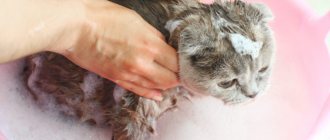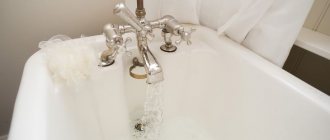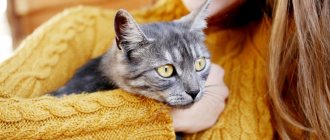How to properly wash a cat
Some owners of cats and cats think that these clean animals are able to independently maintain the cleanliness of their fur and body.
Considering this belief an undeniable argument, careless cat owners try to wash their pets as rarely as possible, increasing the frequency of this procedure to 1-2 times every couple of years. However, professional breeders are convinced that such an attitude towards animal hygiene on the part of their owners is unacceptable. In representatives of the cat family, like in most living beings, the skin over time becomes covered with a layer of dirt, dust, secretions of the sebaceous glands and other contaminants.
https://www.youtube.com/watch?v=upload
In the absence of timely washing, the layer of dirt and sebum becomes thicker and denser. This not only leads to the fact that the animal begins to look unkempt, but also inevitably causes itching and the development of infectious skin diseases.
In addition, a layer of sebum and dirt, as well as hair that has gathered into tangles and lumps, are ideal conditions for the proliferation of parasites and pathogens of dangerous diseases.
The main reasons why an animal needs bathing:
- pollution of wool and skin;
- molting;
- the appearance of parasites and fleas;
- preparation for the exhibition.
Animals brought home from the street also require a bath.
The ears, neck, abdomen, axillary and inguinal folds are subjected to especially careful examination.
It is important to remember that bathing an animal brought from the street is an extremely difficult, unpredictable and time-consuming job.
There is an opinion that cats need bathing during heat. According to observant breeders, this procedure does not play much importance at this stage of the pet’s life. However, in some cases, bathing may really be necessary - for example, when a cat during estrus gets very dirty, rolling around on the floor in the most unexpected corners of the apartment.
In addition, some cat owners claim that in some cases bathing slightly alleviates the condition of their pets during estrus. According to experienced breeders, during this difficult period for a cat, bathing acts as a distraction.
The washed animal “switches” to putting itself in order, temporarily stops meowing plaintively and wandering around the house in search of a partner.
The frequency of bathing kittens, cats and cats is a very conditional indicator, depending on many factors.
First of all, it is determined in accordance with the individual characteristics of the pet - its breed, length and color of fur, skin type, habits and lifestyle. An important role in the frequency of the procedure is played by where and in what conditions the animal is kept - in a house, a city apartment or on the street.
Animals with medium-length hair require bathing, on average, once every 3-4 months, and long-haired pets - once every 2-3 months.
Light-colored cats and toms are bathed more often than their dark-haired counterparts - about 4 times a year. In general, breeders remind us that animals with semi-long and long hair are not recommended to be washed more than 6 times a year.
The situation is more complicated with sphinxes, whose bathing should be approached with special attention. Some breeders of this breed wash their pets about 2 times a month, others prefer to alternate bathing with wiping their pet with a damp cloth.
In both cases, you should focus on the individual characteristics of the pet (for example, some sphinxes simply love to bathe and swim). It would not be superfluous to consult a veterinarian on the most acceptable frequency of bathing the Sphinx.
After water procedures, it is necessary to place the pet in a dry and warm room without drafts. Leaving the animal after bathing in a cold, drafty room is strictly prohibited.
It is also prohibited to bathe kittens, cats and cats during illness, during the postoperative period and for two weeks after vaccination (vaccination). It is not allowed to bathe kittens in the first months of life, as well as nursing cats and cats in the final stages of pregnancy.
It is better to postpone bathing for a while even if the animal has recently eaten. In this situation, water procedures can provoke vomiting. Also, you should not bathe a pet that has suffered stress or is in a stage of severe fright, excitement, or anxiety.
Cats do not need to be washed daily or weekly; bathing once every 2 months is considered normal. Watching the cat, it is easy to notice that in her free time from playing and feeding, she likes to “preen” - licking her fur, paws and tail. The animal keeps its fur clean on its own, so it does not need regular bathing.
Interesting fact: cats and cats groom themselves differently. Cats spend more time licking their fur and do it more thoroughly than males.
It is important to distinguish between thoroughly washing the cat with shampoo and wiping individual areas of the coat as it gets dirty. If the cat got dirty in the toilet or came home from the street, wipe off the dirt with a soft cloth previously moistened in warm water. This will not harm the pet.
You need to teach a kitten to wash from the age of 4-5 months, so that bathing becomes a habitual ritual, and, as an adult, he would not experience fear of water. In any case, you will have to wash your domestic cat throughout its life, because its fur gets dirty and matted, and you really want the “fur coat” to always be luxurious and well-groomed!
Trim your cat's nails to prevent him from scratching you while bathing.
Comb the fur and remove tangles.
Choose a place for bathing - a bathtub, sink or basin. The bathtub is perfect for large cats; you just need to cover the bottom with non-slip bedding. Many owners wash their pets in sinks. The option with a basin is less convenient, since the cat may begin to grab onto its edges; give preference to a container with a volume of about 30 liters or buy a special bath.
Remove all foreign objects from the sides of the bathtub or sink, hide washcloths and other things that the cat can get caught on.
Make sure you have everything you need to bathe your pet on hand:
- shampoo selected specifically for cats (laundry soap and detergents are not suitable for humans - cats have a different skin Ph);
- a hat that covers the cat's ears, or cotton swabs that can be placed in the ears, or you can tie a small bag on your head like a scarf;
- soft washcloth for washing hair;
- a large towel in which to wrap the cat after washing so that it does not freeze and cannot scratch you;
- standard towel for collecting remaining moisture and drying;
- caring assistant (preferably).
Check the temperature in the room where you are going to wash your cat. Pets can easily become hypothermic and get sick, so the air should be no colder than 22 °C.
Pour water into the bathtub, basin or sink in advance. The cat is more afraid not of the bath itself, but of the sound of water pouring from the tap. Before starting water procedures, add warm water to a level of about 10 cm so that the water reaches the cat’s belly. The animal must stand confidently on its paws, but so that its head does not get wet.
Before the water gets cold and the cat suspects something is wrong, grab her and take her to the bathroom. Talk to your purr gently, do not make sudden movements that could frighten your pet. Don't forget to close the door - if the cat escapes, it will be difficult to catch, and wet paw marks will remain all over the apartment (possibly along with foam, if you manage to soap the cat).
Gently place the cat in the bathtub, basin or sink. During the dive, you can hold it by the scruff of the neck to prevent the pet from breaking free and scratching you. Put a bathing cap on him or put cotton swabs in his ears. Run warm water over the fur, avoiding the eyes, nose and ears.
It is likely that the cat will be unhappy and begin to resist. She will have to be persistent - for her own good. Grasp the cat's shoulders directly under your chest in your left hand if you are right-handed. This way, your dominant hand will remain free and can be used to lather the animal. If the cat is waving its hind legs, then you just need to sit it down and hold it so that it cannot jump and kick.
At this stage, the assistant will make your task much easier - he can water the cat from a watering can or shower, supply shampoo, a towel and other necessary items, and you will do all the manipulations with your free hand.
Note: pet stores suggest using a short leash with suction cups to bathe your cat. This accessory makes sense to use only as a last resort, since the pet may be more afraid of the leash than the washing, and in the future it will be difficult to lure the cat into water treatments.
Now apply shampoo to the wet cat's fur with light massaging movements. Consistently soap your back, chest, belly and tail, don’t forget about your paws and chin. Do not use too much shampoo so that you do not have to wash off the foam for a long time.
Using a special washcloth, gently wash the cat's face. If you want to wash your cat's hair, ask an assistant to pinch his ears or put cotton swabs in them. Also make sure that water does not get into your cat's nose.
It's time to thoroughly rinse your cat's fur. Rinse off the foam strictly from top to bottom. It is convenient to wash off the shampoo with a hand shower, just do not lift it very high. Residues of detergent should not remain on the cat's skin, as this may subsequently lead to irritation.
Useful video
Visually learn how to wash a cat with tar soap!
Laundry soap was one of the main hygiene products for Soviet citizens. So they used it for washing, washing, and bathing pets. Modern cat owners have access to pet shampoos, but they continue to believe in the amazing properties of laundry soap.
Aggressive components
Lye is included in this detergent. The substance in high concentrations causes burns, and in moderate concentrations it dries out the skin and causes crusts and dandruff to appear.
What are the dangers for a cat when bathing with laundry soap? Allergies, rashes and itching. The pet's fur becomes faded and slick. The hairs become tangled and can only be removed with scissors.
We must not forget that cats constantly lick themselves, and if the remaining soap is not washed off well, the alkali will end up in the animal’s stomach. Several such baths, and poisoning is guaranteed.
Laundry soap does not protect against fleas. You can use it to wash your cat's paws if your pet decides to walk through the mud, or a greasy tail, but carefully wash off any remaining product.
What to bathe with?
There are many cat shampoos sold in pet stores. They clean the fur and get rid of parasites. For one-time use, children's or "adult" shampoo is suitable, but such a cosmetic product cannot be used regularly.
When should you bathe a cat?
It is necessary to bathe a cat only if there are good reasons for doing so. Indications for washing your pet:
- More than 2-3 months have passed since the last bath, and the cat’s fur has become dull, darkened, and matted;
- the cat is very dirty, for example, rolled in the mud or covered in paint;
- If parasites are found in the fur, you need to immediately bathe the cat and then treat the “fur coat” with an antiparasitic agent. You should especially carefully examine cats that are often outdoors and can “catch” ticks and fleas;
- washing may be recommended by a veterinarian if a cat develops allergies, lichen, dermatitis and other skin-related diseases;
- if you find a kitten on the street and decide to take it into the house, then you cannot do without water procedures;
- In preparation for the exhibition, you will have to wash the cat with a special shampoo and give your pet a “styling.”
When water treatments are contraindicated
Is it always possible to wash a cat with regular shampoo? Sometimes any water procedures are contraindicated for pets, even with the use of cat detergents. You cannot bathe an animal in the following cases:
- If the cat is pregnant or nursing babies. During this period, animals are susceptible to colds. In addition, unnecessary stress is contraindicated for a pregnant pet.
- Old animals should not be washed. In older cats, the nervous system is especially vulnerable.
- You should not wash cats that have undergone surgery.
You should also avoid water treatments if the room is too cold. Swimming is allowed when the air temperature in the room is at least 22 degrees.
Washing a cat with human hygiene products is only possible in exceptional cases. It is better to stock up in advance on a sufficient number of cat shampoos that are made taking into account all the characteristics of the animal’s fur and skin.
Contraindications for swimming
In some cases, you cannot wash your cat:
- during rehabilitation after surgery. Typically, complete recovery takes about a month, but it all depends on the degree of intervention in the body and the pet’s health condition;
- late pregnancy. Washing can be very stressful for a cat and can even cause premature birth;
- within 2 weeks after vaccination. The cat’s immunity is weakened, and it is better to postpone washing;
- if the animal is sick, bathing can worsen its condition. Cancel water procedures and follow the veterinarian’s recommendations.
Baby shampoo: a last resort solution
What to do if you urgently need to bathe your tailed pet, but the pet shampoo has run out or there is no way to purchase it? No matter how dirty your pet is, it is better not to use regular shampoo to wash it. If there are children in the family, it is better to use baby detergent. It is much safer for the animal.
Firstly, shampoos for children do not contain allergenic components. Secondly, they do not have a pungent odor. Thirdly, their production does not use dyes, which, if accidentally ingested by a four-legged pet, can lead to severe poisoning, especially if it is a kitten.
How to wash a cat that is afraid of water
https://www.youtube.com/watch?v=https:8twIgKP22sY
One of the common mistakes that can permanently cement a panicky fear of swimming in an animal’s memory is incorrectly selected water temperature. Most members of the cat family are very sensitive to changes in environmental temperature, which cause them great anxiety.
You can determine the desired temperature level during the preparation process using a special water thermometer. If you don’t have such a device at hand, you can try to estimate the water temperature “experimentally”. To do this, immerse your elbow or wrist in a basin of water. The water temperature should not cause discomfort, either cooling or, on the contrary, burning the skin.
During washing, the condition of the animal should be monitored. If it is trembling, frantically moving its paws, trying to escape, you can add a little hot water to the basin, bringing its temperature to 40°, but not higher.
In some cases, warm water helps to relax the muscles and, as a result, slightly calm the pet.
It is very important to thoroughly dry the animal's fur after it has been bathed.
Some caring owners, trying to help their animals get themselves in order quickly, try to dry their pets with a hairdryer. The use of this device is not prohibited only if the blow-drying procedure is well known to the cat and does not cause panic.
In other cases, the use of a hair dryer is strongly not recommended. The fact is that the animal experiences stress after bathing, and the noise of a working hair dryer can at this moment aggravate the pet’s condition.
For this reason, after bathing, the animal should be given the opportunity to calm down and clean itself up in a secluded, warm and dry corner.
Important: you should not wash your cat after feeding or immerse it in water with its head.
When the shampoo is rinsed, remove the purr from the water, wrap it in a large towel and hug your “cocoon” for a few minutes. The cat should come to its senses and calm down.
Firstly, do not neglect trimming their nails before washing, because during bathing, especially impressionable cats become very belligerent.
Then play with your cat thoroughly to get him relaxed and tired. You cannot feed your pet.
Having lulled the mustache-striped vigilance, start washing. You need to lower your cat into the water gradually, distracting him with toys. Water should be poured in advance so that the cat does not wait extra time and is not afraid of the unusual sound.
No matter how the cat behaves while washing, there is no need to yell at it or physically punish it - this will only bring additional stress to the animal. To limit movement, you can use a special bathing net, where the cat is placed, like in a bag, and does not go anywhere. Maybe it will remind him of his favorite box?
After finishing washing, treat your cat with a treat - this way she will know that there is a reward waiting for her for bathing!
If your pet still cannot overcome its panic fear of water, you can wash it with dry shampoo. This is a great alternative to traditional shampooing because a good dry shampoo cleans almost as well as a liquid shampoo. Apply the powder to the cat's fur, wait a minute and brush the powder and dirt out.
Dry shampoo for cats: pros and cons
Shampoos for cats and kittens can be regular (to remove dirt and foreign odors from fur), caring (bleach white fur, improve the condition of the coat and skin), medicinal (anti-flea, antifungal). They are available in liquid and dry form. Shampoo in the form of powder, mousse, spray or foam is a good alternative to liquid detergents.
Dry pet shampoos are very popular. Their demand is due to the following qualities:
- Ease of use. Powder, spray, mousse or foam is applied to the pet’s fur and after a certain time is removed with a brush.
- There is no need to use water, which is especially important if your four-legged pet has hydrophobia.
- Possibility of use in any conditions. Dry shampoo can be used all year round, regardless of the air temperature in your home. It is convenient to use while traveling.
- Painless and easy untangling of tangles thanks to the antistatic component.
- It is impossible for water to get into your pet's ears.
- Possibility of use in all categories of animals, regardless of age, health characteristics and physiological state.
- Possibility of frequent use.
Dry shampoos have several disadvantages:
- they are not able to cope with severe pollution;
- their particles are noticeable on dark wool;
- Inhaling the product may cause shortness of breath and spasms in your pet.
How to dry wool correctly?
Take the freshly washed cat into the room and dry it with a towel. For short-haired cats, one towel will be enough, and for long-haired cats, do not skimp on 2-3 pieces. You can place your pet on a newspaper or hoe so that the dripping moisture is absorbed faster.
For your information: a cat has a so-called air cushion between its skin and the top layer of fur. This layer of air is heated by the animal's body heat and protects the cat from freezing. During bathing, the fur gets wet and temporarily loses its thermoregulatory properties, which is why it is so important to warm the cat with towels after washing and protect it from drafts.
If the cat is not afraid of a hair dryer, then about 10 minutes after bathing you can lightly dry his fur. The air flow should be warm, but not hot. If the cat is afraid of electrical appliances, it is better to wait until the “coat” dries naturally.
https://www.youtube.com/watch?v=ytcopyrightru
Use a special comb to comb the fur.
After washing, your domestic cat needs to stay warm for at least an hour.
Is it possible to wash a kitten with laundry soap?
The most natural soap is considered to be laundry soap. It is valued for its good cleaning ability. But it is wrong to believe that it is suitable for bathing kittens.
Common people believe that they can wash cats with laundry soap. It’s better not to do this, but to choose a less aggressive one, with a low alkali content or a neutral PH level.
If there is no special shampoo and the kitten needs to be washed, a solution of laundry soap will do. It is suitable as an emergency measure. The cat may develop dandruff and itchy skin after a bath. Some cats experience hair loss, and allergic reactions are possible.
If you find problems after washing with laundry soap, you should immediately contact a veterinarian. He will tell you how to minimize the effects of alkaline attack on the skin.
How to wash your cat's eyes and ears
So, even the most capricious cat was washed, but during bathing we went around the eyes and ears, and they should also be clean.
The cat's eyes are wiped with a cotton swab dipped in clean boiled water or a weak solution of tea or chamomile. Movements should be light, no need to press or rub your eyes.
It's time for ears. There is no need to clean them unless they become dirty. However, after washing the cat, water could get into the ears. You need to wipe the outer part of the ear with a cotton swab, on which it is better to twist an additional layer of cotton wool. Use a clean stick or dip it in a drop of Vaseline oil.
Is it possible to wash cats with tar soap?
Tar soap, according to many breeders, is a real panacea in the fight against blood-sucking insects. Let's see if this is true. Any animal, even if it is completely domestic, has been infected with fleas at least once in its life, the larvae of which you could bring home on clothes and shoes. Pedigree cats, as well as show cats, are vaccinated against blood-sucking insects once every three months, and special notes are included in the veterinary passport.
Tar soap is a very primitive, cheap, but effective way to combat invasion. Thanks to the phenols, alkalis, citric acid and sodium salts it contains, soap repels insects. Benzene contained in birch tar has a paralytic effect on the nerve centers; alkali has an antiparasitic effect, burning through the shell of parasites.
In relation to insecticidal (antiparasitic) agents, soap with a tar component has a number of advantages:
- Absence of poisons, alkaloids of hazardous substances and heavy metals. Many modern parasite control products contain toxic substances, which is why they should be dosed and used with caution.
- It is allowed to use in the presence of wounds, abrasions, and other skin diseases.
- Tar soap can be used to treat animals against parasites as early as six to eight weeks of age, because it does not dry out the skin and maintains water balance. Even in human medicine it is prescribed as a prevention of skin diseases.
- The biggest danger of using tar soap is that its foam gets on the mucous membranes, as well as in the eyes and ears. Modern insecticidal preparations, when licked by animals, can cause severe forms of poisoning, paralysis and even death.
Disadvantages of using soap:
The larvae and eggs of parasites are insensitive to birch tar - it affects only mature adults. Bathing should be repeated two to three times every four to six days.
Washing a cat with tar soap is easy:
- Place the cat in the bath, wet its fur with warm (up to forty to forty-five degrees Celsius) water.
- Break off a piece of soap and lather until rich foam appears.
- Lather the wool using a bar of soap.
- Hold your pet for three to five minutes, even if he resists.
- Rinse off the foam with water and wrap the cat in a towel. Try to comb out fleas in the area of the ears and face.
- If your pet allows it, comb the fur a couple of times.
Many veterinarians believe that tar soap is a thing of the past, and modern shampoos can quickly and safely deal with parasites. They are not that expensive and are available to everyone.
Each owner must decide for himself what means to treat his pet in order to minimize risks.
Constantly is not possible. Laundry soap has a very hard and heavy structure for cat skin. After using it, dandruff is likely to appear. You may notice other allergic reactions.
It is acceptable to use laundry soap once, in extreme cases, when the animal needs to be bathed urgently, and there is nothing more suitable at hand.
Features of washing cats of different breeds
A common myth concerns Sphynx cats - supposedly because of their oily skin they need to be washed once a week. In fact, it is better to wipe the Sphynx with wet wipes or a soft cloth, and bathe it only if it is very dirty.
The Burmese cat has a very impressive, shiny, short coat, the beauty of which must be maintained. Instead of washing fine fur, which can make your cat look like a hedgehog, wipe it daily with a piece of suede or a damp cloth. This will help give the “fur coat” a glossy shine. Once a week, the cat should be combed with a mitten or brush. You can use a special cat antistatic agent. Your chocolate will definitely love this massage!
British cats and Maine Coons have sensitive skin, so it is extremely important for them to select specialized shampoos based on their coat type. From low-quality cosmetics, cats can begin to constantly itch and develop dandruff.
Which shampoo to choose
How to use regular shampoo correctly? Can I wash my cat with any human hair product? Only baby shampoo is suitable for animals. This tool has the following advantages:
- Baby shampoos do not contain dangerous allergens.
- Shampoos for babies do not have a strong and pungent odor.
- Baby shampoos do not contain dyes that can cause poisoning for your pet.
Can I wash my cat with regular shampoo and conditioner? This is highly undesirable. Products with conditioner negatively affect the condition of your pet's coat. It is better to choose shampoo intended for small children under 3 years old. It is the safest for animals.
How often should I bathe?
According to the standards set by experts, pets need to be bathed three or four times a year. If the animal is often taken outside, the frequency of water procedures should be doubled. It’s also worth washing your cat’s or dog’s paws every time after a walk.
You should not arrange water procedures very often. Especially if you don’t have special detergents, and you don’t know how to wash your cat if you don’t have a special shampoo. Due to the fact that there are fewer and fewer bacteria on the animal's body, its immune system gradually weakens. Natural protection disappears, as a result of which the cat may develop health problems.
Despite the recommended frequency of bathing cats, it is better to do it as rarely as possible. If the animal already has a not entirely pleasant odor, you can carry out water procedures. It is best to focus on a balanced diet for your pet, which will enable the body to fight any infections.










